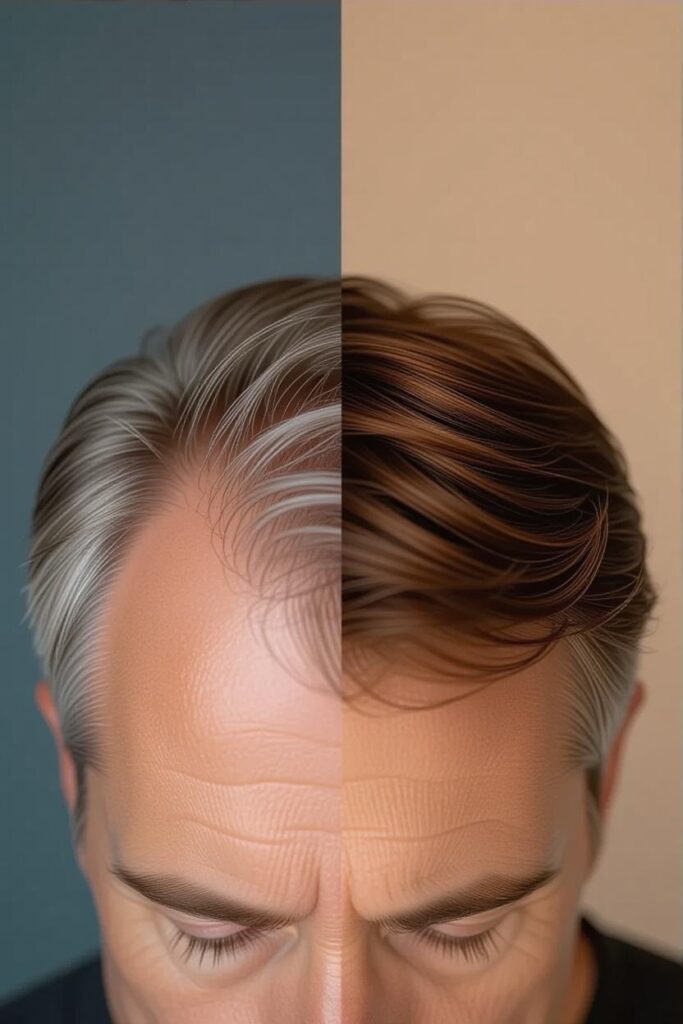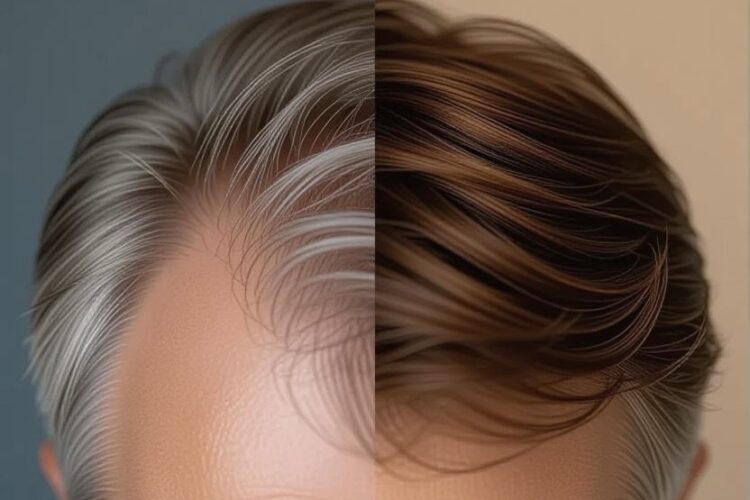Hair loss, or alopecia, affects many with thinning hair, balding, or shedding. Common types include androgenetic alopecia (male/female pattern baldness), telogen effluvium (stress-related shedding), and alopecia areata (autoimmune patches). Causes range from genetics and DHT to hormonal shifts, nutrient deficiencies (like iron or biotin), and tight hairstyles. To reverse hair loss, use FDA-approved minoxidil or finasteride, or try spironolactone for women. Corticosteroids help autoimmune cases, and antifungals treat scalp infections. Hair transplants or laser therapy work for advanced cases. Boost regrowth with scalp massages, rosemary oil, and a diet rich in multivitamins and omega-3s. Manage stress via meditation and avoid heat styling or chemical treatments. Emerging treatments like deoxyribose sugar gels show promise by improving scalp circulation. See a dermatologist for tests like a scalp biopsy to diagnose issues early. Consistent care over months can restore fuller hair.
Long Version
How to Reverse Hair Loss: A Complete Guide
Hair loss affects millions worldwide, manifesting as thinning hair, balding, or baldness that can erode confidence. Known medically as alopecia, this condition isn’t always permanent—many can regrow hair, reverse hair loss, or at least slow hair loss through targeted strategies. Whether you’re dealing with a receding hairline, pattern baldness, or excessive hair shedding, understanding the underlying mechanisms empowers you to act. Advances in treatments offer real hope, from proven medications to emerging therapies, making hair regrowth more achievable than ever.
At its core, hair loss disrupts the natural hair cycle, which consists of the anagen phase (active hair growth lasting 2-7 years), catagen phase (transition, 2-3 weeks), and telogen phase (resting, 2-4 months) before shedding and restarting. Factors like genetics, hereditary traits, androgens, or dihydrotestosterone (DHT) can shorten the anagen phase, leading to reduced hair density and eventual hair breakage or loss. Recognizing this cycle is key to interventions that promote stem cells in hair follicles and enhance blood vessel formation for nourishment.
Types of Hair Loss: Identifying Your Condition
Hair loss isn’t one-size-fits-all; different forms require tailored approaches to prevent hair loss or achieve hair regrowth. Androgenetic alopecia, the most common, includes male pattern hair loss (often a receding hairline and crown thinning) and female pattern hair loss (FPHL), where DHT sensitivity shrinks follicles. Telogen effluvium causes widespread hair shedding after stress or hormonal fluctuations, while anagen effluvium results from treatments like chemotherapy, halting growth mid-anagen phase.
Autoimmune diseases trigger alopecia areata, creating patchy bald spots, or more severe variants like alopecia totalis (full scalp loss) or universalis (body-wide). Cicatricial alopecia, including central centrifugal cicatricial alopecia and frontal fibrosing alopecia, involves scarring that destroys follicles permanently if untreated. Lichen planopilaris and discoid lupus erythematosus inflame the scalp, leading to similar scarring. Traction alopecia stems from tight hairstyles pulling on roots, and tinea capitis (scalp ringworm) is a fungal infection causing inflamed patches. Rarer conditions like hypotrichosis involve congenital sparse hair.
Early identification matters—consult a dermatologist for a pull test (gently tugging hairs to assess shedding) or scalp biopsy to examine follicles under a microscope. These diagnostics reveal if inflammation, autoimmune disease, or nutrient deficiency is at play, guiding effective reversal.
Root Causes: Why Hair Loss Happens
Hair follicles, the tiny structures producing strands, are sensitive to internal and external factors. Genetics and hereditary predispositions make some more susceptible, especially to androgens converting testosterone to DHT, which miniaturizes follicles in pattern baldness. Hormonal fluctuations from polycystic ovary syndrome (PCOS), pregnancy, menopause, or thyroid issues disrupt balance, elevating cortisol (the stress hormone) and accelerating shedding.
Nutrient deficiency plays a major role—iron deficiency anemia reduces oxygen delivery to follicles, while biotin deficiency weakens strands, and lacks in folic acid or omega-3 fatty acids impair growth. Stress, both physical and emotional, pushes more hairs into the telogen phase, causing telogen effluvium. Inflammation from autoimmune conditions or scalp infections like tinea capitis exacerbates damage.
Lifestyle culprits include tight hairstyles causing traction alopecia, heat styling tools leading to hair breakage, and chemical treatments weakening shafts. Poor scalp health, from dandruff to buildup, stifles regrowth. Addressing these holistically—through diet, stress management, and gentle hair care—can halt progression and foster reversal.
Diagnosis and When to Seek Help
If you notice thinning hair, increased hair shedding, or reduced hair density, don’t wait. A dermatologist evaluates via medical history, visual exam, and tests like bloodwork for iron deficiency or hormonal imbalances. A pull test quantifies loose hairs, while a scalp biopsy identifies scarring in cicatricial alopecia or inflammation in lichen planopilaris.
For fungal issues like scalp ringworm, microscopic analysis confirms. Early diagnosis prevents irreversible damage, especially in frontal fibrosing alopecia or central centrifugal cicatricial alopecia, where prompt intervention preserves follicles.
Proven Treatments to Reverse Hair Loss
Reversing hair loss combines medical, procedural, and lifestyle options. Start with FDA-approved medications: Minoxidil (Rogaine) topical solution widens blood vessels for better nutrient flow, promoting hair growth in androgenetic alopecia. Finasteride (Propecia) and dutasteride (Avodart) block DHT for men, while spironolactone (Aldactone) and other antiandrogens help women with FPHL or PCOS.
For autoimmune-driven alopecia areata, corticosteroids (topical steroids or steroid injections) reduce inflammation, often restoring patches. Antifungal medication treats tinea capitis effectively. In discoid lupus erythematosus, managing the underlying autoimmune disease is crucial.
Procedural options shine for advanced cases. Hair transplant surgery relocates healthy follicles from donor areas to balding spots, yielding natural regrowth over months. Laser therapy with low-level laser devices stimulates follicles via light energy, enhancing hair density.
Emerging research highlights stem cells for regenerating follicles and deoxyribose sugar gels to boost blood vessel formation, potentially rivaling minoxidil without side effects. A 2025 study showed this natural sugar triggers robust regrowth by improving scalp circulation.
Natural and Lifestyle Remedies for Hair Regrowth
Complement medical approaches with daily habits. Scalp massage increases blood flow, awakening dormant follicles—combine with essential oils like rosemary oil or lavender oil, which rival minoxidil in studies. Use anti-thinning shampoo or volumizing shampoo free of harsh chemicals to strengthen strands.
A balanced diet rich in multivitamins, omega-3 fatty acids, biotin, folic acid, and iron combats deficiencies. Stress management through meditation or yoga lowers cortisol, preventing telogen effluvium. Adopt gentle hair care: avoid tight hairstyles, limit heat styling, and skip chemical treatments to reduce breakage.
Natural fixes like vitamin C, cysteine, and plant extracts (saw palmetto, pumpkin seed) to inhibit DHT and support keratin. Red light therapy and microneedling also recharge mitochondria for better growth.
Prevention: Safeguarding Your Hair Long-Term
To slow hair loss and maintain density, prioritize scalp health. Protect from UV damage, quit smoking, and manage chronic conditions. Consistent routines—nutritious meals, stress reduction, and proper care—fortify follicles against hereditary risks.
In 2025, with advancements like sugar-based therapies enhancing blood supply, reversing hair loss is more promising. Patience is essential; results emerge over 3-6 months as the hair cycle renews. Track progress, adjust as needed, and consult professionals for personalized plans. With the right combination, you can reclaim fuller, healthier hair.

Hashtags For Social Media
#HairLoss #Alopecia #HairGrowth #HairLossSolution #HairLossTreatment #HairTransplant #ThinningHair #RegrowHair #NaturalHairGrowth #Balding #FemaleHairLoss #MalePatternBaldness #HairRestoration #HealthyHair #DHTBlocker #Minoxidil #HairCare #AlopeciaAreata #PostpartumHairLoss #StressHairLoss #HairRejuvenation #HairRepair #RegrowHairNaturally #HairGrowthSolution #ScalpMicropigmentation #PRP #FUE #HairTransformation #AlopeciaAwareness #PreventHairLoss
Related Questions, Words, Phrases
how to reverse hair loss | ways to stop balding naturally | best treatments for thinning hair | can hair loss be reversed | how to regrow lost hair | natural remedies to reverse alopecia | effective methods to combat receding hairline | how to prevent and reverse pattern baldness | top tips for hair regrowth at home | is it possible to reverse male pattern hair loss | female hair loss reversal techniques | how to fix hair shedding and promote growth | proven ways to reverse telogen effluvium | supplements that help reverse hair thinning | how to use minoxidil to reverse baldness | laser therapy for reversing hair loss | what causes hair loss and how to reverse it | diy solutions to reverse traction alopecia | medical treatments to reverse androgenetic alopecia | how long does it take to reverse hair loss | home remedies for reversing frontal fibrosing alopecia | scalp massage techniques to reverse balding | foods that help reverse nutrient deficiency hair loss | how to reverse hair loss from stress | essential oils for reversing alopecia areata | surgical options to reverse permanent hair loss | how to reverse hair loss in women with pcos | biotin and other vitamins to reverse thinning hair | how to identify and reverse early signs of baldness | natural ways to block dht and reverse hair loss | how to reverse hair loss after chemotherapy | red light therapy for reversing pattern baldness | how to reverse cicatricial alopecia scarring | yoga and stress management to reverse telogen phase hair loss | how to reverse hair loss from tight hairstyles






